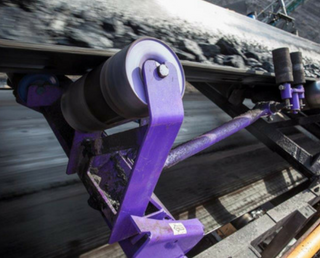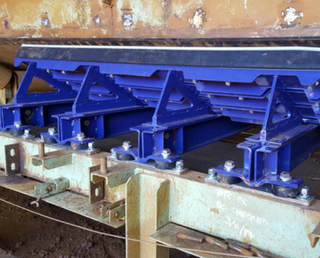Addressing Challenges Before The Load Point: Could This Be The Answer to Load Zone Issues?
Do you want to solve mistracking, spillage or premature wear issues at your load point? Here are some tips that are sure to help.
When a load point is not set up properly, poor performance can lead to spillage and even equipment damage. But spillage and equipment damage at the load point isn’t inevitable. Evaluating and optimizing the belt conveyor at load points can do wonders for a belt conveyor system and its productivity.
When evaluating the load point, it is wise to start by looking at the areas preceding the load point. For example, one of the primary causes of load-point spillage is actually a result of poor conveyor belt tracking prior to loading.
 Mistracking and spillage
Mistracking and spillage
Mistracking can be a costly and sometimes dangerous problem. If caught early and fixed, a mistracked conveyor belt does little damage to the conveyor. However, if ignored, other types of damage can occur.
A conveyor belt that is constantly hitting a structure damages both the structure and frays the edge of the belt. In extreme cases, the width of the conveyor belt is reduced by several inches, which reduces the amount of material it can carry. If a conveyor belt mistracks enough, it will spill material off of the topside onto the area around it, which could result in safety violations.
MSHA (Mine Safety and Health Administration, in the USA) also considers evidence of a belt rubbing on a structure a fire hazard, an issue that mine safety organizations around the world would agree is dangerous, and can issue citations to underground coal mines..
Many times the load point is near the tail pulley. Since it is critical to center the conveyor belt before loading, the question arises of where to locate a conveyor belt tracker or trainer device. An easy solution is to install a return side belt trainer slightly upstream of the tail pulley. Usually, if the conveyor belt is centered as it goes around the tail pulley, it will be centered through the load zone.
Conveyor belt mistracking is a common problem that can be simple to fix and make a big impact on your bottom line. Here’s another blog I wrote on how to keep your conveyor belt on track.
An immediate result of a bad load point is spilled material landing on the return flight of the belt. This is a significant hazard to the life and well-being of your conveyor belt. While wing and wrap pulleys are used to allow space for fugitive material to slip by and prevent damage to both the belt and the pulley, they can still capture larger lumps of material and become damaged and uneven.
In the case of crown and flat pulleys, there is no protection from spilled material which that will damage the pulley, lagging, and belt. Installing a belt conveyor plough before the pulley will clear material from the belt and prevent damage from conveyor belt spillage. Both diagonal ploughs (all materials cleared to one side) and V-shaped ploughs (material cleared to both sides) are useful in this case.
 Transition distance and premature wear
Transition distance and premature wear
Even transition distance can have an impact on the load point. Transition distance is the length of conveyor belt used to transform from a flat shape exiting the pulley to the trough shape used to carry material. Often transition distances are compromised to save space, but this can cause many problems, including premature conveyor belt wear, premature pulley lagging wear, conveyor roller failure, and conveyor belt cupping due to belt carcass damage.
Because of this, CEMA (Conveyor Equipment Manufacturers Association) recommends transition distances of up to four times the belt width, depending on the troughing angle, conveyor belt tension, and belt carcass construction. A conservative estimate for a 35-degree troughed fabric belt is to have at least 1.6 times its width as a transition distance.
Addressing challenges before the load zone
The success of any part of the conveyor is dependent on several different areas of the system. It is for this reason that an evaluation of the entire system can only benefit an operation. A few simple changes to a system can increase efficiency and productivity and decrease the amount of time spent crunching numbers to cut costs.
Authored by: Kevin Fales, Product Manager
Fales manages the belt conveyor product (BCP) line, providing product development and engineering with guidance on market requirements for both new product concepts and existing products. He also leads the development of technical and promotional literature supporting BCP line. Fales graduated from Grand Valley State University with a bachelor’s degree in Marketing and is currently working toward his master’s degree in business administration from Western Michigan University.
Subscribe to the Flexco Blog
Related Blogs
Published Date
October 12, 2018Product Groups
- Belt Cleaning Systems
- Belt Positioners, Trackers, and Trainers
- Impact Beds and Skirting Systems